Report
 }
}
Executive summary
How should consumer goods companies respond when the world’s hottest market cools to a slow simmer? Is it time to abandon the illusion that China and its massive shopper population hold the keys to the future for companies selling fast-moving consumer goods (FMCG)? Should retailers scratch aggressive expansion plans for China and look elsewhere? Stick to their playbook and wait for the market to reheat? Or, is it time simply to acknowledge that growth in the world’s second-largest market for consumer goods has slowed to a pace that is more realistic—and far more sustainable—than in previous years?
It’s no secret that today’s China is different. The FMCG retail market grew 5.4% in 2014 compared with 11.8% three years prior. During this deceleration, some stores experienced negative same-store sales growth. Retailers became more cautious about expansion and, in certain situations, did something virtually unimaginable five years earlier: They closed stores. Leading retailers took a regional (city/province-based) approach to the expansion of physical stores, a strategy that helped them gain more market share than their competitors.
While the brick-and-mortar world of FMCG exhibited lackluster performance, the opposite was true for China’s dynamic e-commerce landscape. Online sales rose 34% in 2014 as e-commerce retailers expanded penetration and as online shoppers dramatically increased their purchasing frequency. Online pure-play retailers such as Taobao and Tmall continued to dominate in 2014, while omnichannel players were just emerging.
Online, Chinese shoppers exhibit the same lack of loyalty as they do in physical stores. However, certain distinctions between online and offline shopping behaviors are coming into focus as e-commerce expands. For example, the 10 top categories of FMCG differ across online and offline channels, and the concentration of the top 10 categories is much higher online (accounting for nearly 80% of online purchases compared with about 40% offline). Shoppers tend to go online to purchase premium products, a trend that results in a higher average selling price (ASP) for products bought online. It is therefore not surprising that imported goods enjoy higher value share in online channels (about 40% online compared with 10% offline), thanks to increased access to global e-commerce. Motivated by free or low-cost delivery, online shoppers opt for bigger orders and larger quantities. And online shoppers are particularly eager to take advantage of special promotions. In fact, approximately 40% of online purchases are made during popular promotions like Double 11 and Double 12 sales events, both of which delivered huge spikes in digital sales in 2014.
In the years ahead, FMCG retailers in both offline and online channels will need to adapt to slowing growth. Offline, winners will take a focused approach to store expansion, aiming to increase penetration on a region-by-region basis and making a push for smaller-format stores. Online, they’ll strive to make the most of shoppers’ category preferences, desire for premium brands, willingness to buy in larger quantities and fondness for promotions. The most successful retailers in both channels will intensify their efforts to develop and implement online-to-offline (O2O) strategies.
Full report
China offline: FMCG retailers in turbulence
China’s fast-moving consumer goods (FMCG) retail market is advancing in different directions. Physical store retailers grapple with lower productivity in some formats and are reevaluating expansion plans. In contrast, opportunities abound for e-commerce retailers.
Our tenth consecutive study of the shopping behavior of 40,000 Chinese shoppers helped us gain insights into these and other important trends that retailers face in China. As in previous years, we equipped research participants with barcode scanners to track what they purchased, rather than relying on what they said they’d purchased. This unique approach gives us a clear picture of the purchase activity of shoppers across 106 categories of FMCG.
The total urban FMCG retail market grew by an annual 5.4% in 2014, a drop from the prior year’s rate of 7.4% (see Figure 1).
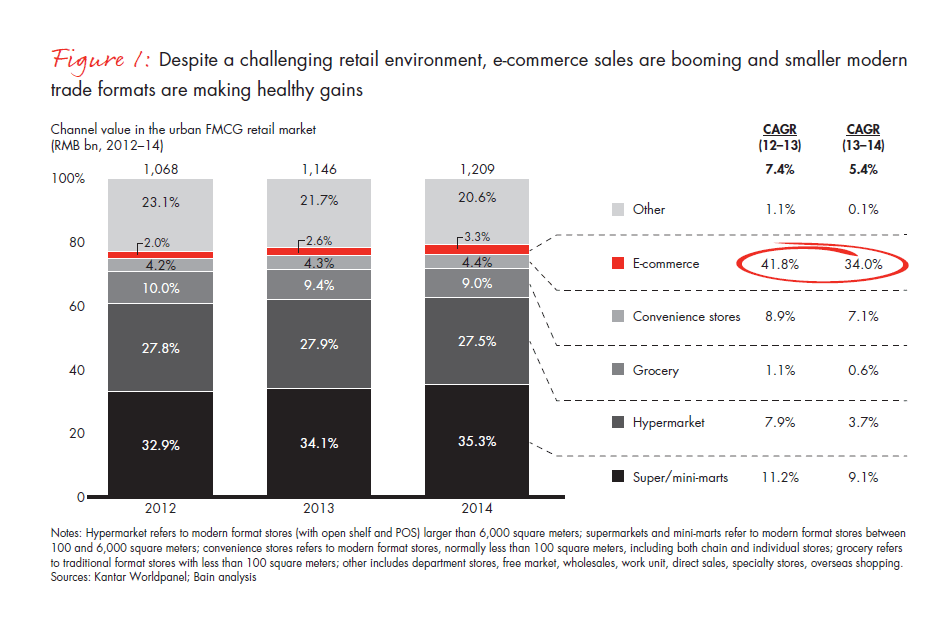
In the brick-and-mortar world, modern trade (including the hypermarket, supermarkets and mini-marts and convenience store formats) overall registered minor gains.1 However, modern trade penetration and growth varied widely depending on format and city tier. Most modern trade retailers started out in top-tier cities and with larger formats (hypermarkets and large supermarkets). As large stores approached the saturation point in terms of penetration, retailers started to develop smaller formats, such as mini-stores. These super- and mini-mart formats performed well in 2014, growing at a healthy 9.1%, the best rate among all modern trade formats. Meanwhile, traditional grocery stores grew by only 0.6% throughout the country.
Major retailers have also found themselves struggling with same-store sales growth (see Figure 2).
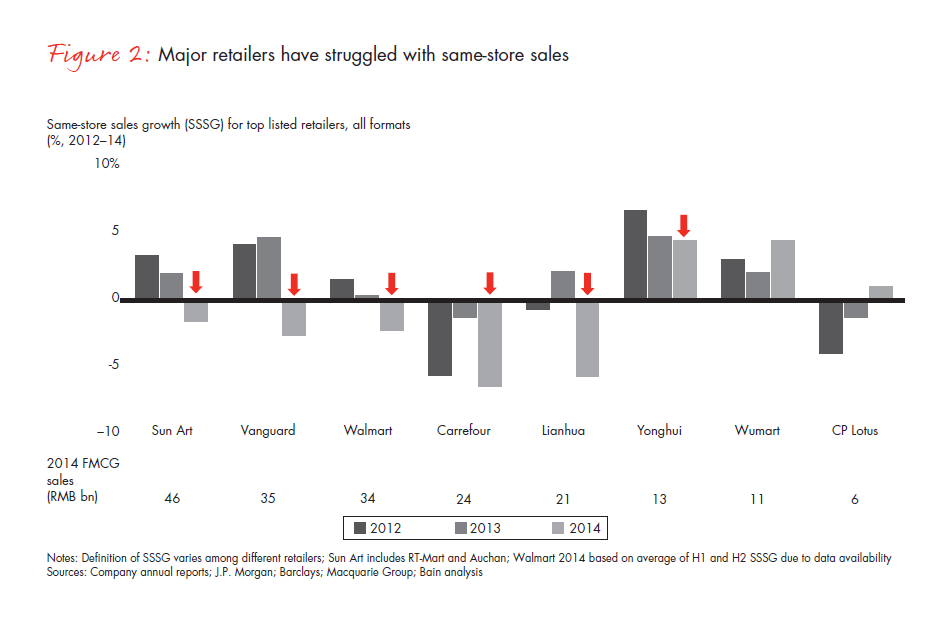
Notably, some listed companies experienced declines of more than 5%. In addition to inefficient operations, geographic focus may cause declining same-store sales growth (SSSG). Retailers with a high percentage of their outlets in Tier-1 and Tier-2 cities, for example, were likely to experience lower SSSG due to lower FMCG growth in top-tier cities. In addition, new stores typically benefit from high SSSG during their first three years, so retailers with a high percentage of new stores will enjoy a high overall SSSG. Similarly, a retailer that closes underperforming stores will see its SSSG improve. In addition, cleaning up big purchases and back-door sales will also have a negative effect on retailers’ SSSG.
Most retailers opened fewer stores or even closed some locations (see Figure 3). Yonghui closed about 15 stores in the past two years; Carrefour closed about 25 stores and Walmart closed about 30 stores. In some cities, retailers closed stores due to overcapacity and rising rental costs. Among major retailers, only Vanguard and Wumart opened a greater number of stores in 2014 than in 2013.
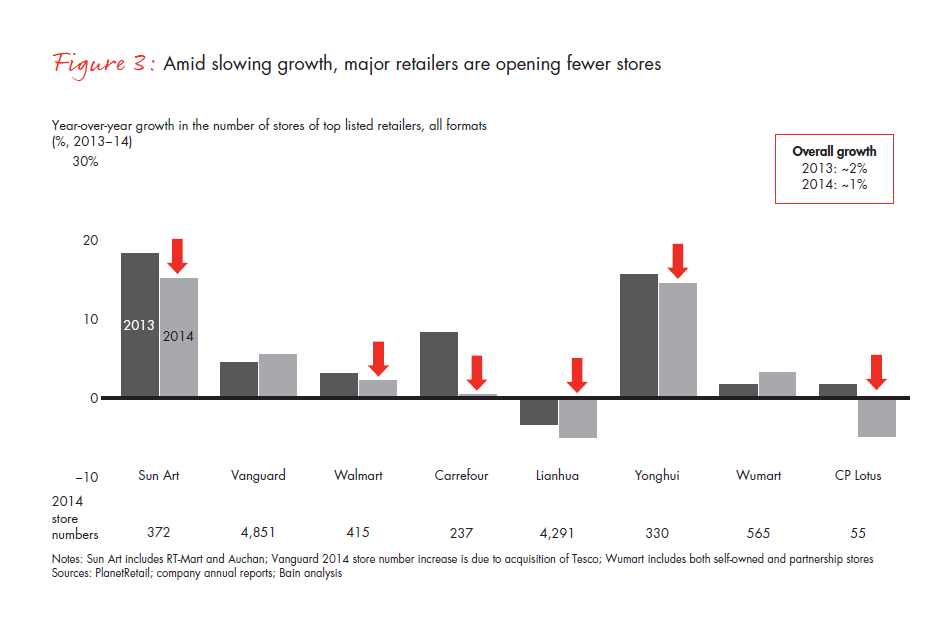
In the battlefield that is China’s FMCG retail market, smaller retailers outpaced their larger competitors in 2014. On an aggregate basis, companies that were not among the top 20 retailers by sales value achieved three times the growth rate of their larger counterparts and accounted for 91% of the growth from 2013 to 2014 (see Figure 4).
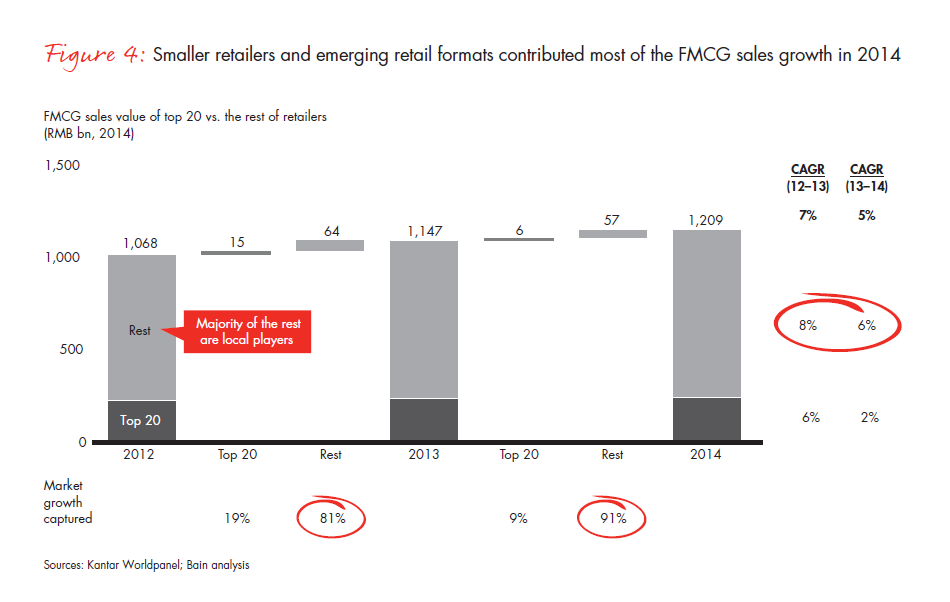
Many of these small players win by maintaining a local or regional focus, an approach that enables them to adapt to the challenging environment.
Among the top 20 retailers, foreign and Chinese retailers have similar share nationwide (51% vs. 49%), but compete in different city-tier battlefields. In the past two years, they each attacked the other’s historic strongholds. Foreign retailers have gained share against Chinese retailers in Tier-3 to Tier-5 cities, but at the same time, Chinese retailers grew in Tier-1 and Tier-2 cities where foreign retailers have higher market share (see Figure 5).
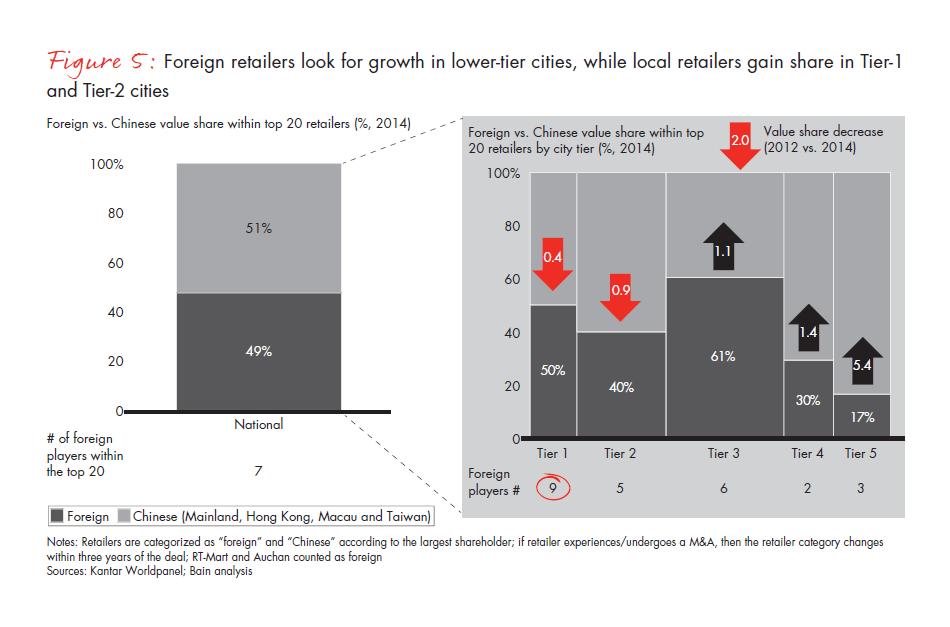
Multinational retailers entered China’s biggest cities and built up bases in those key markets. However, despite their significant presence in Tier-1 and Tier-2 cities and their breadth of experience, multinationals lost ground there in 2014. To recover, they are closing stores and, in some cases, choosing to target smaller cities. For example, expansion efforts by major retailers like Walmart and RT-Mart enabled foreign companies to gain 5.4% share from local companies in Tier-5 cities. Additionally, multinationals have increased their fresh food offerings, which is critical for winning against smaller local retailers.
Because China is a large country, neither top performers’ nor low performers’ results are consistent across regions (see Figure 6). Top performers like Yonghui had varied results across regions. Yonghui gained the most share in the West and North regions—2.7% in the West and 2.6% in the North. The same is true for RT-Mart and Wumart. Their successes are a result of significant share gains in selected regions. Other players also gained share in some core regions. For example, though Walmart lost market share in the East, West and North regions, it gained 1.2% in the South, which is its historical stronghold.
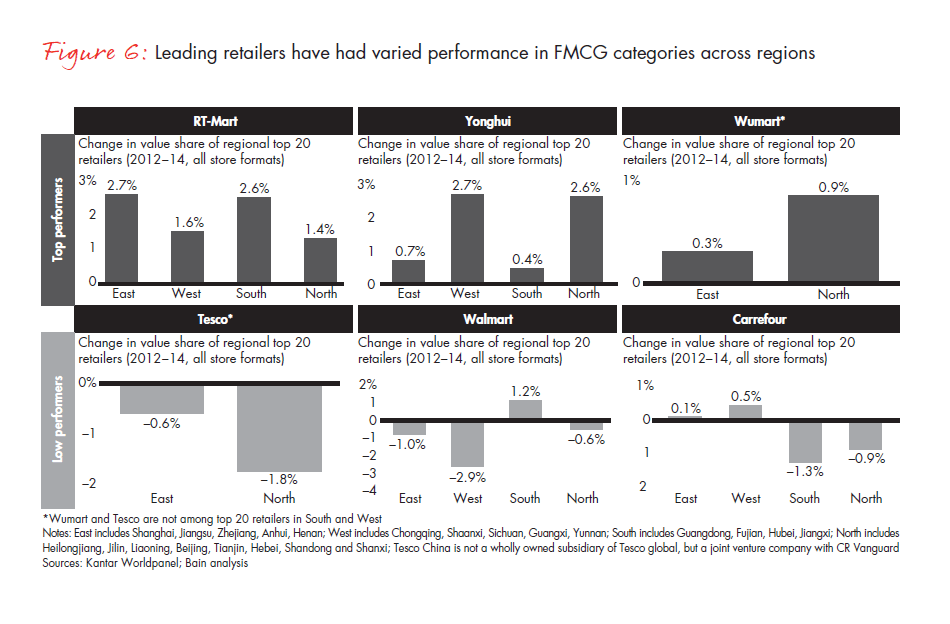
As both local and multinational retailers attempt to position themselves for future growth, they need to focus on a proven ingredient for success in China: achieving regional scale. Sometimes this even means getting to scale in a specific city or province. Consider the geographic footprints of Yonghui, Wumart and Walmart (see Figure 7). About 80% of Yonghui’s outlets are located in Fujian, Chongqing, Beijing and Anhui; nearly 100% of Wumart’s outlets are located in Beijing, Tianjin and Zhejiang; and nearly 50% of Walmart’s outlets are concentrated in Guangdong, Fujian, Sichuan, Jiangsu and Shanghai. In addition to these concentrations, they also proactively built leadership at the city/province level by achieving a leading position in key cities in specific regions. For example, Yonghui’s share in Chongqing, its second-largest market, is 2.5 times that of its nearest competitor. Wumart’s market share in its largest market, Beijing, is 1.6 times that of Carrefour, its closest competitor. And Walmart maintains 2.1 times the market share of its closest competitor in its home base market of Shenzhen. After gaining scale in key cities, leading players began to build scale in surrounding areas to create multi-city clusters.
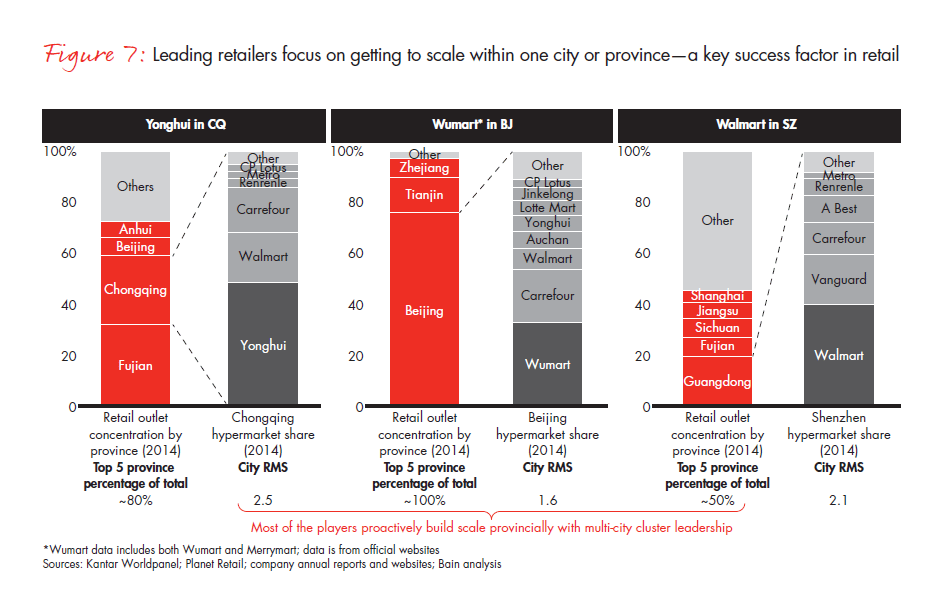
Penetration contributes to city leadership. That’s a major reason why Lianhua is the market leader in Shanghai and Yonghui leads in Chongqing (see Figure 8). Both retailers have succeeded in getting new households to shop in their stores each year. Both companies have also captured a growing share of wallet, another important factor for achieving market share leadership (see Figure 9).
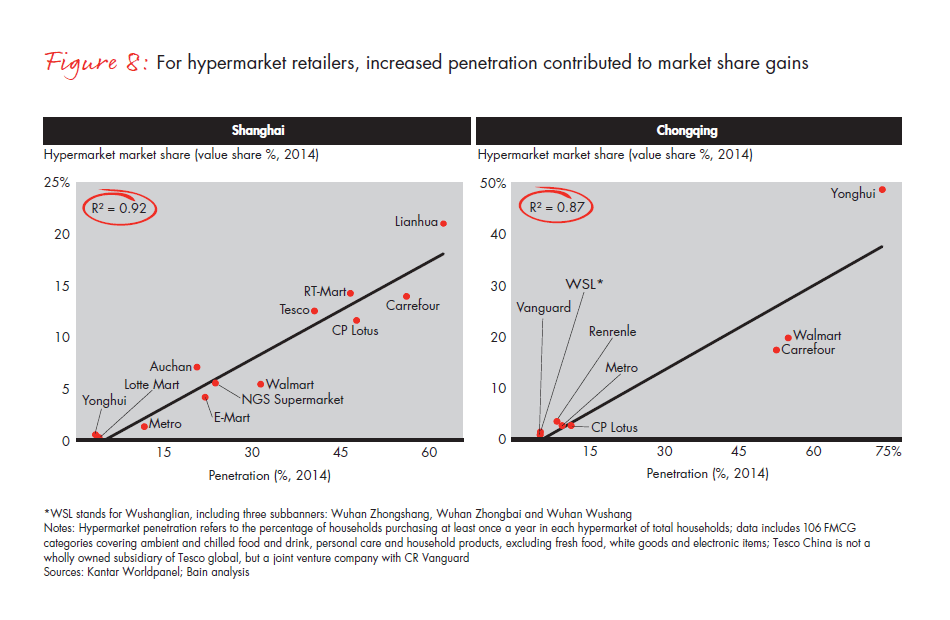
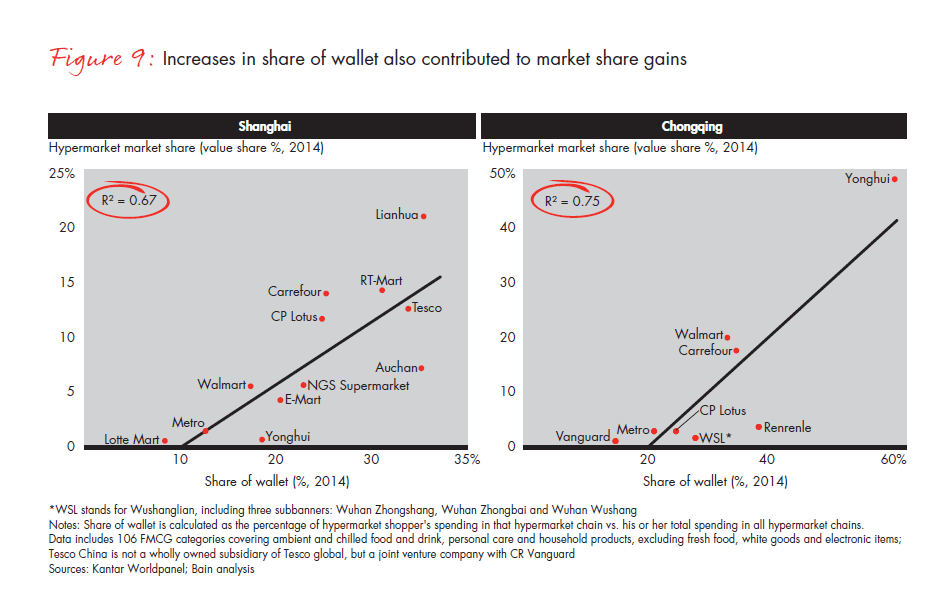
In addition to building regional market share, China’s top retailers are winning by emphasizing unique areas of differentiation. Yonghui uses fresh food as a competitive advantage while RT-Mart distinguishes itself by offering low prices for daily necessities such as eggs. Meanwhile, these top retailers are speeding up the consolidation of China’s retail market in multiple ways. Some have taken equity positions in other retailers. Consider Yonghui’s minority stake in Lianhua and Wuhan Zhongbai. Retailers are also consolidating their supply chains, a move that sometimes involves partnerships among domestic and multinational retailers.
China online: FMCG trends and behaviors
While offline retailers grapple with growth challenges, e-commerce sales in the country continue to boom. In fact, online sales rose 34% in 2014. While this figure represents a drop from 41.8% in 2013, it still represents robust activity and reflects Chinese shoppers’ continued enthusiasm for browsing, purchasing and reviewing products online. If there’s a bright spot for FMCG retailers in China, it’s in the digital realm, where shoppers are willing to spend more in specific product categories and purchase larger quantities.
Chinese shoppers have become such huge fans of online purchasing that it would be hard to find a market where shoppers have more fervently ignited the e-commerce revolution. As the online retail world grows, it’s shaped by digital consumers’ distinct preferences and habits. For example, we estimate that shoppers who were merely switching channels (buying products online that they would have otherwise purchased in stores) generated approximately 40% of e-commerce sales growth. This means that approximately 60% of sales growth was organic—the result of new purchases that shoppers would not have made without the digital option (see Figure 10). On the one hand, the bulk of substitutions represents sales that shoppers would have made in hypermarkets or supermarkets, contributing to the sluggish growth of big-box retailers. However, because e-commerce actually has increased the total retail pie, opportunity exists for physical retailers to grow total sales by devising omnichannel strategies that make the most of both worlds.
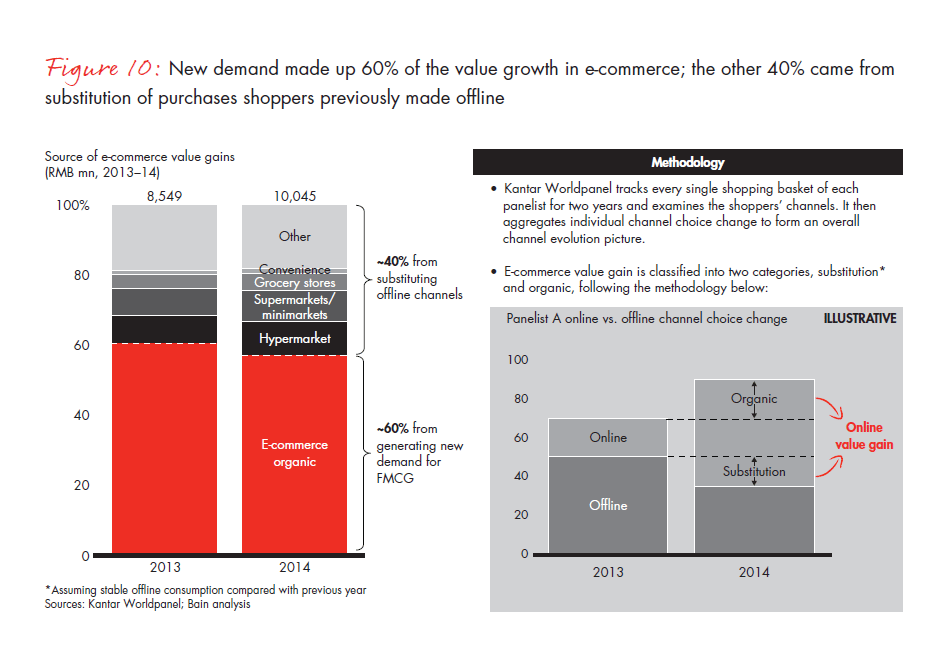
China’s e-commerce boom is spurred by gains in penetration and purchasing frequency. Online penetration in urban areas grew to nearly 36% in 2014, compared with 30% in 2013, with the average urban household making four purchases, compared with 3.6 in 2013 (see Figure 11). The vast majority of purchases took place on the four biggest pure-play e-commerce sites: Taobao, Tmall, Yihaodian and Jingdong (JD.com). Combined, these sites accounted for 90% of all online purchases in China (see Figure 12). But smaller pure-play competitors like Amazon and Womai, and nascent omnichannel retailers like LHMart, Sam’s Club and Metro, have made big pushes to capture more of these sales. However, no company—pure-play or omnichannel, multinational or domestic—poses a major threat to the market domination of Taobao and Tmall.
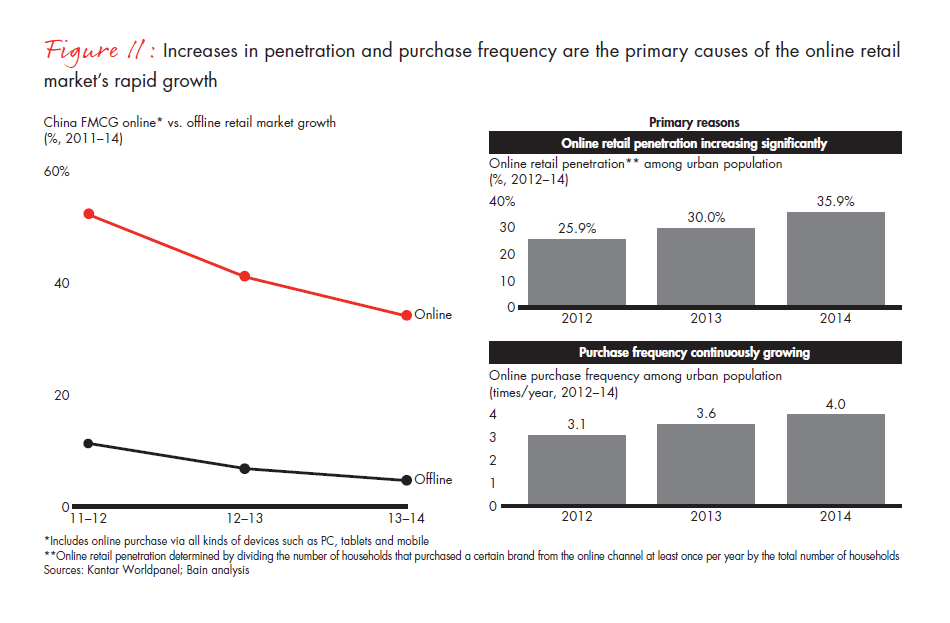
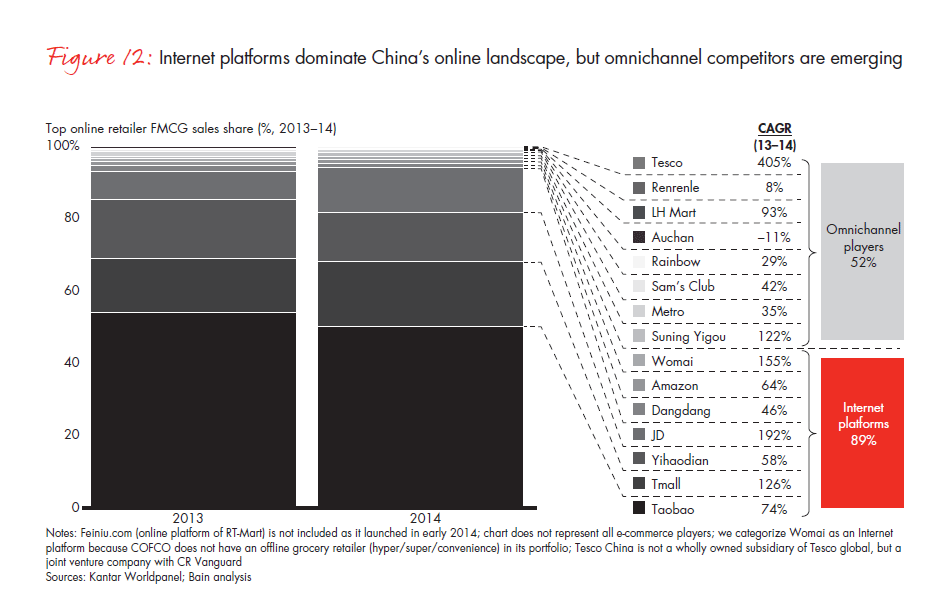
Our research has helped us clearly see the profile of China’s online shopper. Consider the matter of repertoire and loyalist behavior. Shoppers engaging in repertoire behavior purchase multiple brands of the same product for the same occasion or need, and the more they shop, the more they tend to buy multiple brands. In some product categories, however, shoppers are more loyal, repeatedly buying one brand for a specific need or occasion. We found that repertoire behavior with brands purchased offline is mirrored in the online world. For example, shoppers display significant repertoire behavior in skin care and chocolate product categories but are more loyal when it comes to diapers and infant formula (see Figure 13).
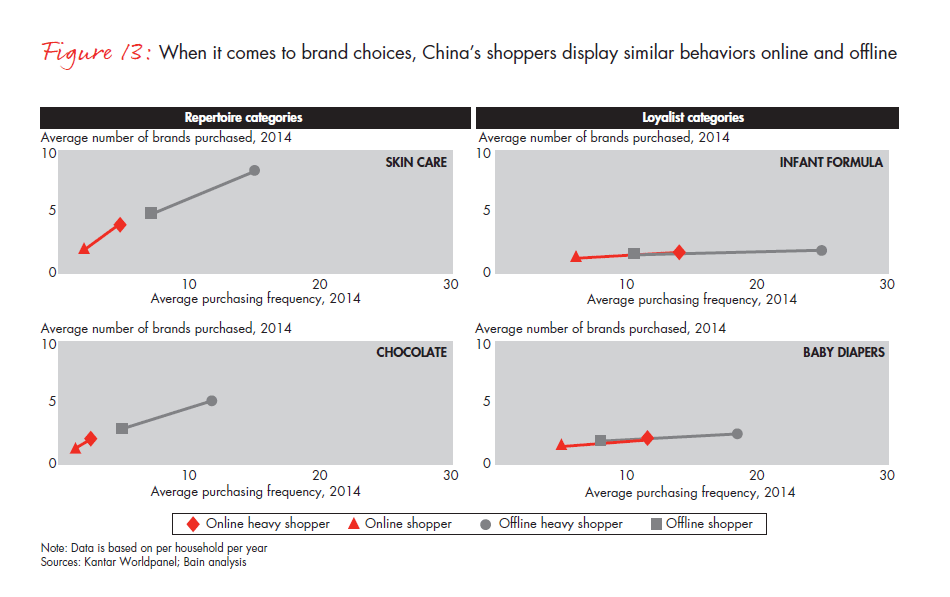
In both offline and online channels, China’s heaviest shoppers (the 20% with the highest purchase frequency) display repertoire behavior with the retailers they patronize: shoppers with the highest purchase frequency shop in more stores than the average shopper (see Figure 14). In other words, the more you shop, the more places you go, both offline and online. On average, however, the heaviest offline shoppers patronize more retailers than their online counterparts.
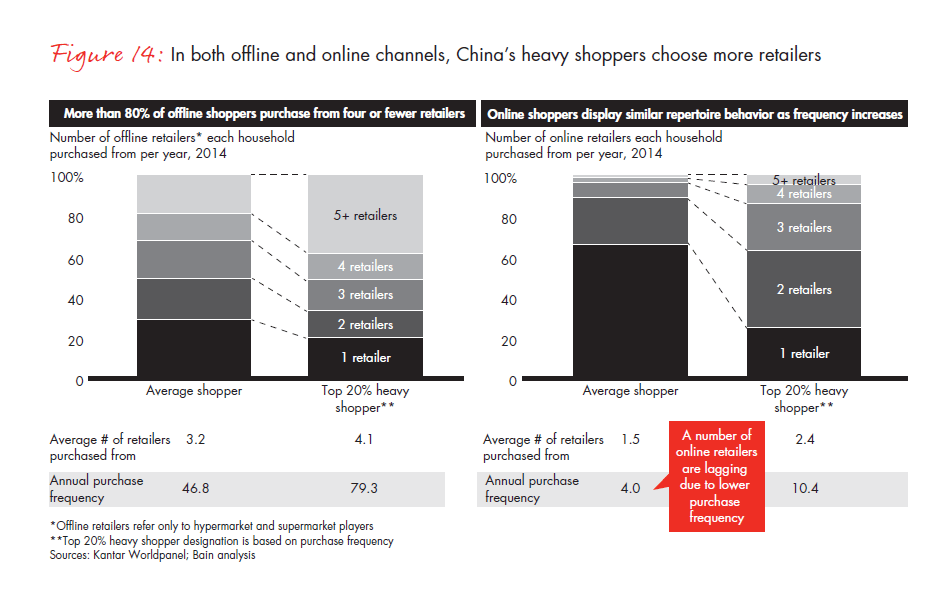
We learned that shoppers buy a relatively limited number of FMCG product categories online. The top 10 categories represent 77% of online sales, but only 43% of offline sales (see Figure 15). The most popular categories purchased online are health-related and easy to ship: skin care, infant formula and baby diapers. One important reason why shoppers prefer to buy health and infant categories online is that they have more faith in the quality of imported products.
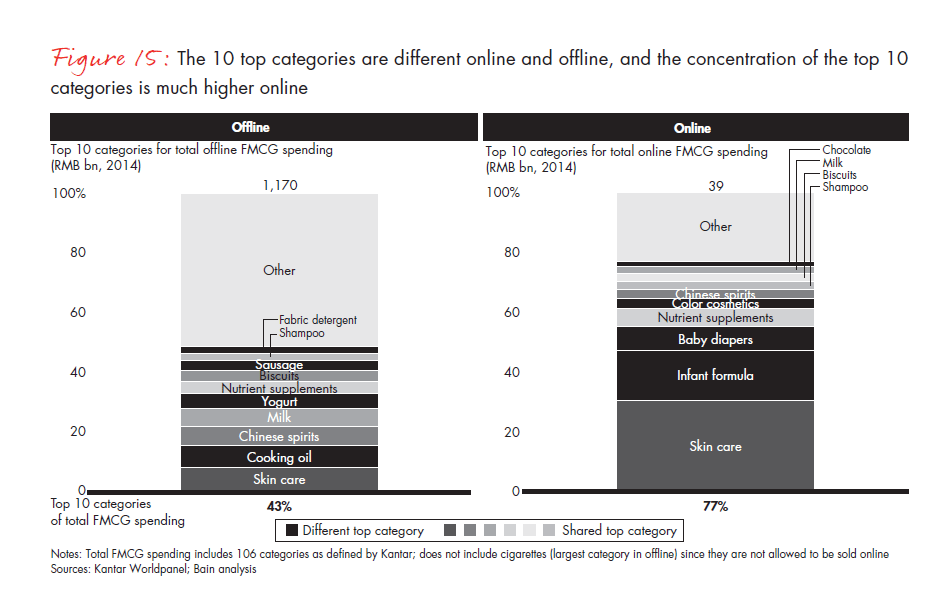
Our survey uncovered another interesting difference in offline and online shopping patterns: When making purchases in categories like skin care, milk and infant formula, shoppers will choose from different offline retailers, but tend to be more loyal to particular online retailers (see Figure 16). It is worth noting, though, that many consumers go to brand shops on Taobao much as they do on Tmall.
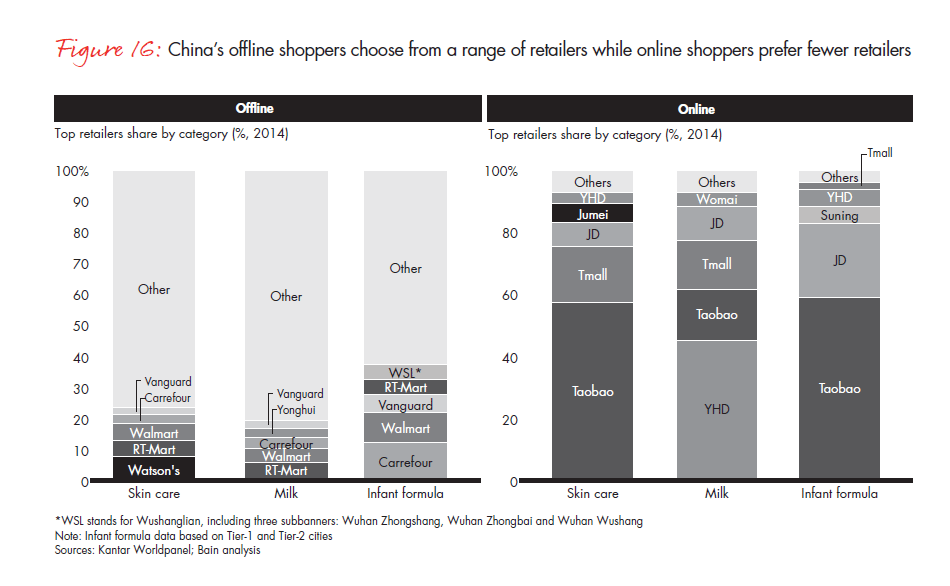
Overall, the price of many similar SKUs is slightly lower online. In many categories, however, shoppers tend to favor premium brands for their online purchases. As a result, the ASP for goods purchased online is higher than for those purchased in physical stores (see Figures 17 and 18). Toothbrushes, beer and hair conditioner showed the biggest price differentials. On average, toothbrushes are 102% more expensive online, in large part because shoppers prefer premium toothbrush brands online. Online market leader Oral-B, with more than 15% market share, carries an average selling price of RMB 57. The second-most popular brand, Systema, sells for RMB 6, still higher than the leading brand offline, Colgate, at RMB 5.
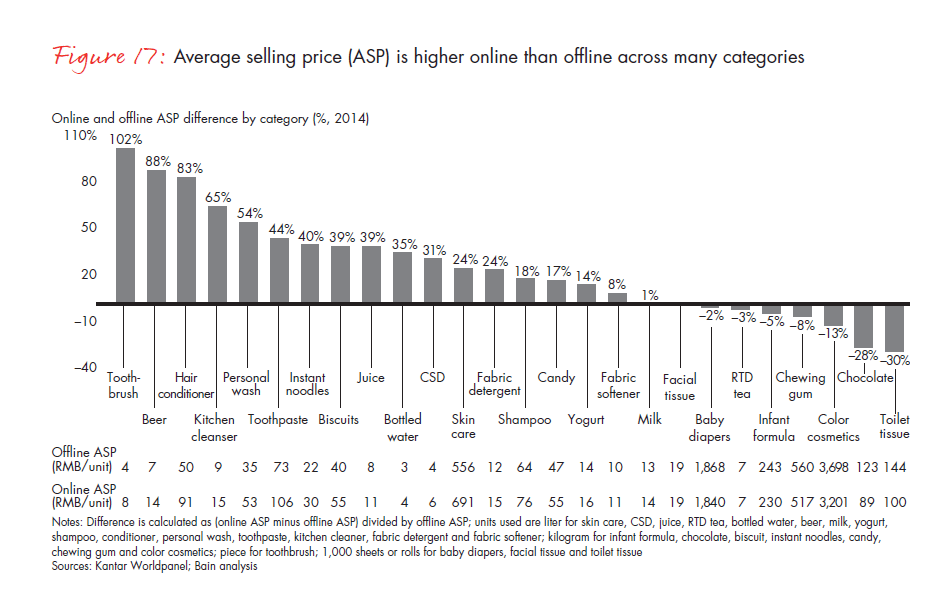
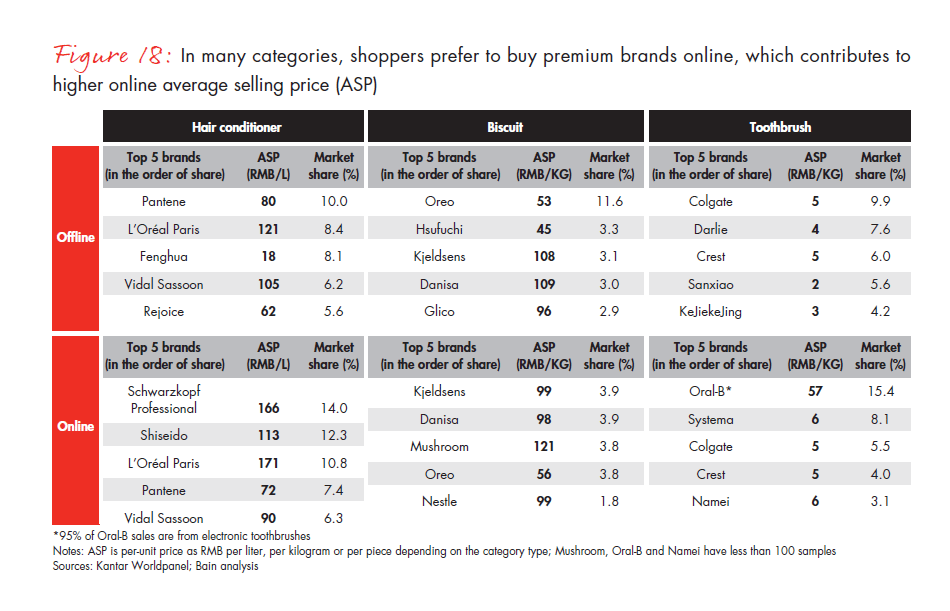
Motivated by the convenience and savings of low-cost or free delivery, shoppers buy in larger volumes online (see Figure 19). The most dramatic example: The average volume per order of bottled water purchased online is 143% higher than the volume bought in a store. It’s a lot easier to have bottled water delivered than to carry it home. Online shoppers prefer larger pack sizes, too.
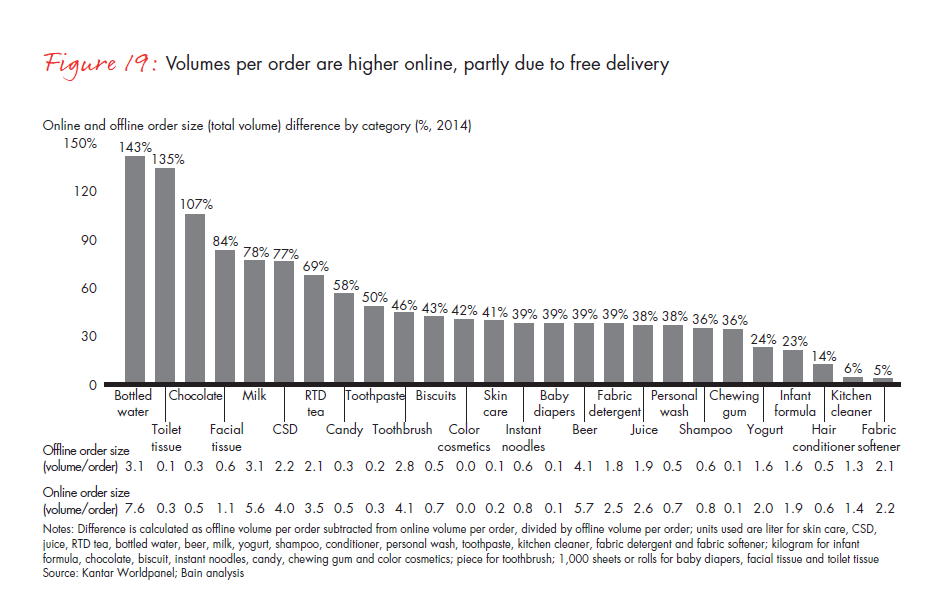
Finally, among the most common traits of online shoppers—and one opening up significant opportunities—is their interest in taking advantage of promotions and imports. Promotions result in only 14% of physical store sales (see Figure 20). That rate is more than doubled online, where 38% of sales take place during such popular promotions as Double 11 and Double 12 campaigns.
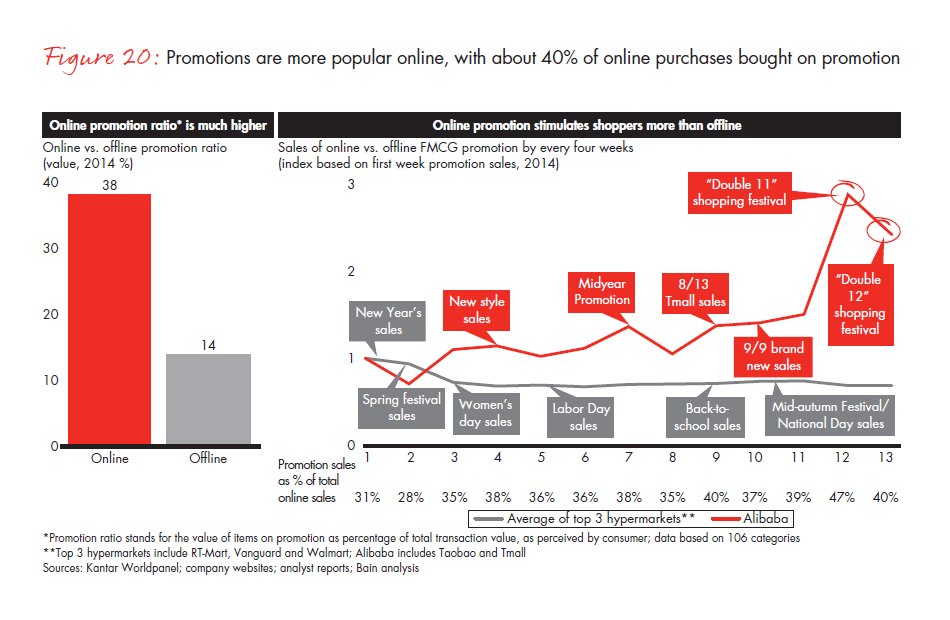
Retailers find it easier to promote online than offline, and shoppers are willing to take advantage. In addition to promotion, imported goods are also prevalent online, with about 40% value share compared with about 10% in offline (see Figure 21). That is mainly due to the fact that e-commerce opened new access to imported goods, which Chinese shoppers perceive as higher-quality and safer than domestic versions. As a result, the majority of today’s FMCG e-commerce sales come from products that are promoted and imported, which together account for about 65% of total FMCG online sales—much higher than the roughly 20% in offline channels.
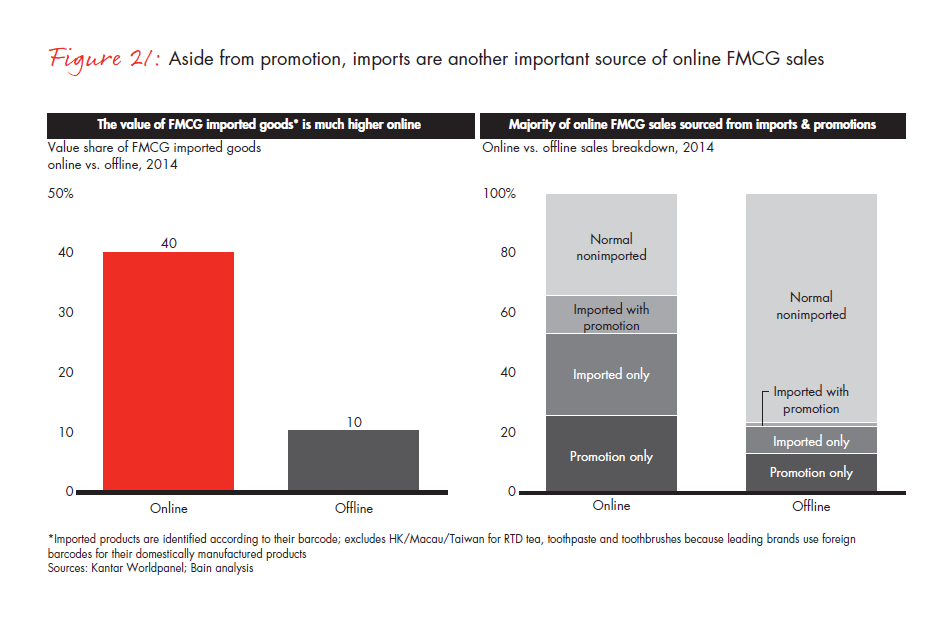
Implications for retailers
What do these findings mean for retailers hoping to win in China’s new normal? The most successful companies will adhere to a local or regional focus for physical store expansion. With sales growth decelerating, winning means establishing leadership in one city or region at a time—and only then expanding beyond. It also means constantly pruning its store portfolio and closing underperforming stores. Meanwhile, with big-box stores no longer experiencing rapid growth, another key to success in China in the years ahead will be developing and introducing smaller formats similar to the Carrefour Easy stores that the French retailer opened in Shanghai. Small-box stores require less investment than larger formats, are more efficient to operate and serve Chinese shoppers’ growing need for convenience. They can also be used to help retailers implement O2O strategies—serving as a site for picking up or returning items purchased online, for example.
Retailers need to prepare for the O2O era, and forward-thinking players are taking aggressive steps. In August, JD.com agreed to invest RMB 4.3 billion (US$700 million) for a 10% stake in Chinese supermarket chain Yonghui Superstores. The move is designed to enable the retailers to benefit from synergies in sourcing, warehousing, Internet finance and IT. More important, though, it will enable the companies to implement an O2O strategy. Also in August, Alibaba bought a 19.9% stake in electronics retail giant Suning, an offline rival, for RMB 28.3 billion (US$4.5 billion). Suning, which has more than 1,600 physical stores across 289 cities in China, invested as much as RMB 14 billion (US$2.28 billion) to take a 1.1% stake in Alibaba. The arrangement gives Suning access to Alibaba’s massive online traffic, while Alibaba can make the most of Suning’s extensive offline network, sharing logistics facilities, for example, and integrating Suning’s stores with Alibaba’s platform.
International retailers, too, are actively preparing for O2O. Less than two weeks before the JD.com and Alibaba deals were announced, Walmart fully acquired the remaining 49% equity share in Yihaodian to become the online food retailer’s sole shareholder.
Brick-and-mortar retailers are taking different paths to their O2O future. Some rely on big e-commerce players like Tmall to reach digital shoppers, while others seed their own online sites. Regardless of preferred approach, the most successful offline retailers will stress the importance of managing customer data. To grow in China’s e-commerce marketplace, retailers need to tailor their offerings based on evolving online shopping behaviors, taking lessons from the category strengths that are fueling pure online players’ fast success. The best companies will optimize their offline and online SKU mix to address online shoppers’ demonstrated preferences for purchasing premium products online. They will make the most of low-cost or free delivery services to spur increases in pack size or bundled product purchases and will thoughtfully take advantage of online shoppers’ enthusiastic embrace of e-commerce promotions and imports.
Bruno Lannes is a partner with Bain’s Shanghai office and leads the Consumer Products and Retail practices for Greater China. Weiwen Han is a partner with Bain’s Shanghai office. Jason Ding is a partner with Bain’s Beijing office. Chenkai Ling is a principal with Bain’s Shanghai office. Marcy Kou is CEO at Kantar Worldpanel Asia. Jason Yu is general manager at Kantar Worldpanel China.
This report is a joint effort between Bain & Company and Kantar Worldpanel. The authors extend their gratitude to all who contributed to this report, in particular Iris Zhou, Zoe Zou, Jacob Zhou, Pengpeng Wang from Bain & Company and Rachel Lee, Tina Qin and Tracy Zhuang from Kantar Worldpanel.
1 Hypermarket refers to modern format stores (with open shelf and POS) larger than 6,000 square meters; supermarkets and mini-marts refer to modern format stores between 100 and 6,000 square meters; convenience stores refer to modern format stores, normally less than 100 square meters, including both chain and individual stores; grocery refers to traditional format stores with less than 100 square meters.




















